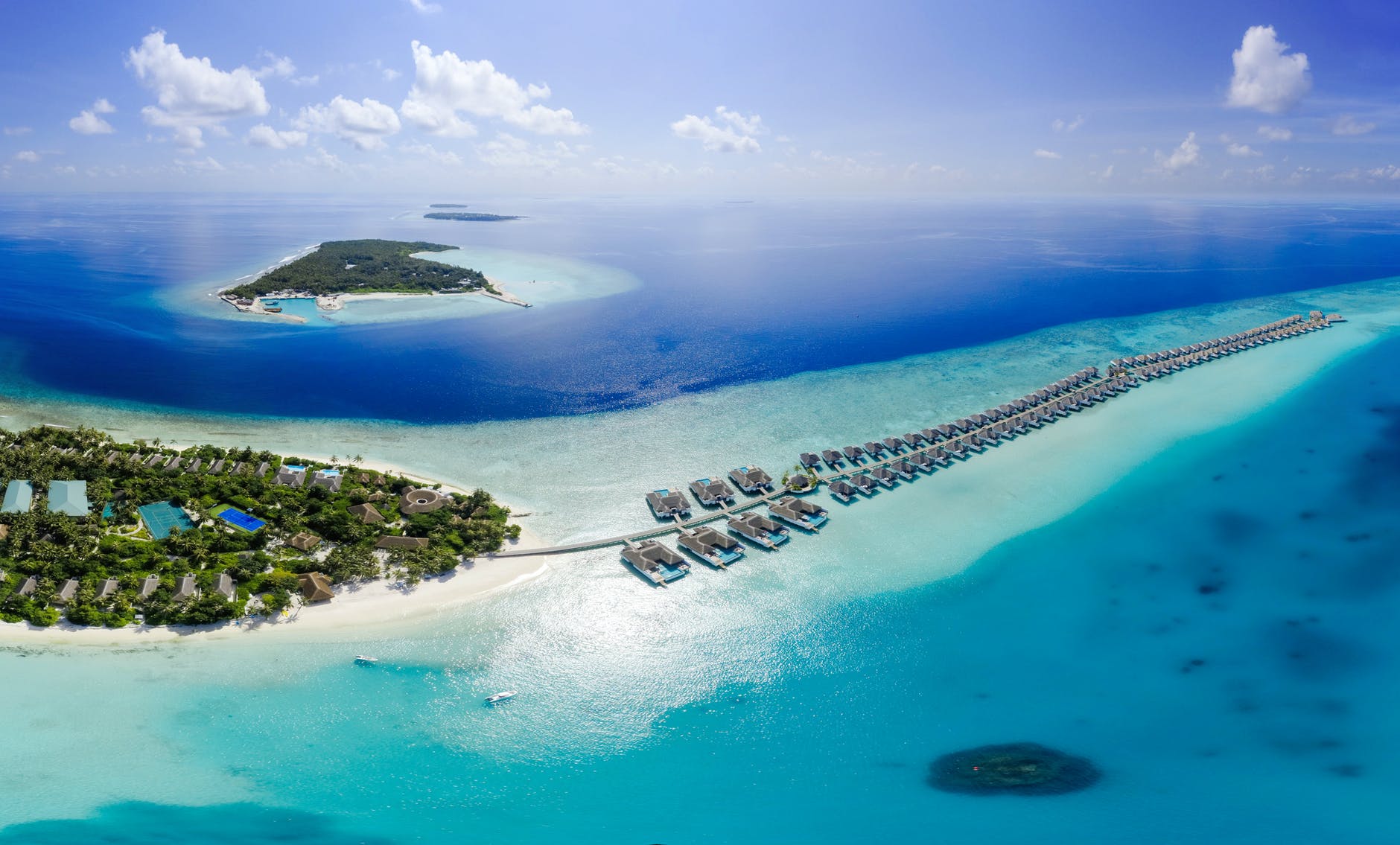We will start our Maldives Travel tips by talking about this nation. The state of the Maldives is a free entity found in the Indian ocean. This is situated at the tip of large undersea rocky mountains.
The gross region of this country is roughly 300 km2. It is the flattest state in the globe, with a median elevation of 1.8 meters above ocean point.
The overall population of this state is about 520,000 citizens. It is among the areas on the planet where whale sharks can be found throughout the year.
About Maldives:
The atolls are of coral roots. These white shores are uncommon, with less than 5 % of the globe shore, the remaining primarily made of quartz. Malé is the capital and economic hub of this state. This is host to 5 out of 7 types of sea turtles in the globe.
In fact, the entire region is situated in a geographic location with links to large foreign trade paths in the Indian Ocean. All the atolls are covered by a lagoon filled with sparkling blue water.
Whereas, these atolls are kept safe by the design of the reef, inhabiting among the most unique and remarkable sea creatures. This archipelago has no equivalents in the globe in contexts of its distinctive location and landscape.
Things to Do in Maldives:

- Malé Atoll
- Hulhumale
- Kuramathi
- Hukuru Miskiy
- Bandos
- Rangali
- National Museum
- Milaidhoo
- Dhigurah
- Moofushi
- Atmosphere Kanifushi
- Veligandu
language :
Dhivehi is the primary and the leading language of Maldives. It’s also popular for the name of Maldivian. Although it contains the use of numerous Hindi and Arabic words, it appears to match different tongues heard in Sri Lanka, southeast Asia, and northern India. there are several other dialects besides the regular Dhivehi, including Mulaku, Huvadhu, Maliku, Haddhunmathee, Mulaku, and Addu. tongue use Thaana ‘s literary pattern, which is across right to left.
By the way, the Maldivian tongue has the unique privilege of adding to the English term “atoll.” It came from the Dhivehi term “atholhu.” Besides Dhivehi, English is another obvious tongue within this part of the globe.
Currency & Banking:
The primary and main currency of Maldives is Maldivian rufiyaa. While 1 Rufiyaa is equivalent to 100 Laari. The bank issues note in denominations of 1000, 500, 100, 50, 20, 10, and 5. Whereas the coin comes in denominations of 1, 2, 5, 10, 25, 50 Laari as well as 1, 2 rufiyaa. Everybody in this corner of the globe considers the US Dollar.
Attractions, cafes & stores welcome all global credit cards, including Visa & Mastercard. Regional areas only budget hotels and major eateries welcome credit cards and cash is usually favored. The majority of banks found in Malé offer cash machine facilities and credit card facilities in Main divisions in Malé and Hulhumale.
Tourist Visa:
Indian folks can get the visa for a total visit of 30 days on arrival.
Documents required for a visa:
- Passport with 6 months validity
- Return air ticket
- Hotel confirmation
- Covid19 test report
- Overseas travel insurance
Best time to visit:
The perfect opportunity to explore the Maldives is between December to April. Throughout these days, the atolls boast of clear conditions. During this time span, there will be no monsoon rainfall. People quite often recognize it as a peak phase for visitors. This time is often known to be the finest time to tour this state for the honeymoon as partners have the freedom to experience all sorts of adventures owing to the perfect climate patterns. accommodation prices are going to be strong throughout this timeframe, but you can uncover the greatest of this archipelago.
According to Maldives Travel Tips, the rainy cycle in this region is from May to November. This is the period when it’s not a crowded season for visitors. However, it is a seaside location that is vibrant and has a climate that is appropriate for a journey throughout the year.
Time Zone:
The time zone at this location is (GMT+5).
Emergency numbers:
- Police: 119
- Fire: 118
- Ambulance: 102
Internet:
The Internet speed in the Maldives is average and the prices are economical. You can buy SIM cards for your phone from the airport or one of many retailers all over this nation. All you need is the passport to get the sim card in this country. While Dhiraagu and Ooredoo are the major internet service providers in this location.
According to Maldives Travel Tips, the areas with free wifi hotspots are restaurants, hotels, airports, and popular tourist places. Whereas about 70.5 percent of the population has internet access. Throughout this state’s remote areas, you will face problems, the connection is not so decent in most places.
Electricity:
The normal voltage is 230 V and the default frequency is 50 Hz. While the electric plugs and sockets are of form D and G in this area. Form D is primarily famous in India, Sri Lanka, Nepal, and some African states. This form only operates with type D. Whereas, form G is of British roots. This form only operates with type G.
However, you can use your power equipment in this location if the normal voltage in your area is between 220 240 V. Although it is advisable to carry a travel adapter to stay connected with the world. According to Maldives Travel Tips, power-cuts usually not happens in this part of the world, even in smaller areas.
Maldives Climate:
The Maldives has a tropical climate. It’s warm throughout the year and it’s impacted by the rainy season. Relative to many tropical regions, the Maldives experience a dry and rainy period. The wet season, through late April to September, is heavier on the northern atolls. It is often characterized by greater moisture and quite intense precipitation. Weather conditions remain constant because they are about 30 ° C maximum and about 25 ° C low much of the year.
The similar moisture is strong and durable across the year, at about 80 percent. However, there is a minor rise in conditions around February and May, and in the realization of rawness. The overall yearly precipitation is a little more plentiful in the southern islands. It floats about 2,200 mm annually in the south and is quite prevalent in the north, where it floats about 1,800 mm annually.
Reasons To Travel:

- Festivals and events
- Islands
- Heritage sites
- Landscape
- History
- Beaches
- Food
- People
- Nature
- Markets
History:
The Maldives has a long tradition heading back. It was truly set up by an Indian prince who had been sent to deportation. somewhere approximately 270 BC, an Indian ruler was sent out of the empire of Kalinga as a penalty to set up over the territories. it is said that Sri Soorudasaruna Adeettiya is the initial emperor of the archipelago. It was then named Dheeva Maari and the Adeetta Kingdom was built in this state. Until the twelfth millennium, Buddhism was the prevailing religion in the region. By the 1200s, It had become a Muslim state.
Middle age
During the next few hundreds of years, civilization grew rapidly as ships and sellers took the regional market spinning. In the 1900s, the Britain colonization troops built up the atolls into a Britain colony. Britain built the Maldives with an army power and undertook not to intervene with regional governance policy. It last until 1965 & On July 26, 1965, the island became free from Britain’s control.
Modern times
The island became the Republic of the Maldives After 2 years. In 2004, the Boxing Day tsunami-damaged most of this nation, causing upwards of $400 million in destruction. In fact, the head of state was violently overthrown by an army uprising, contributing to civil instability and public turmoil in the capital.
Culture:
The Maldives has a rich and colorful culture. Society has a heavy influence of Indian, Sri Lankan, Malaysian, Arab, Persian, Indonesian, and also African traditions. Classic drum device, Bodu Beru (large drum) is a symbol of Maldives’ strong friendship with East Africa several generations back. The music of Bodu Beru is rather melodic and can be seen as spiritual. Maldivian food relies on main products including shrimp, coconuts, breadfruit, millet, and tubers. This is a vibrant mix of common spices with heavy contributions from its surrounding nations, including India and Sri Lanka.
Food & Festivals
Masroshi, Mas Huni, Garudihya, and Gulha are the major dishes of this area. Dhivehi Libaas, a typical outfit ornate with ladies, is special to the region with its stitching methods. It ‘s more regarding showcasing the embroideries that are popular as Kasabu Viyun. Males wear the Maldivian sarong & also famous with the title Feyli. The Eid Festival, Prophet’s Birthday, National Day, and Independence Day are the major festivities of this nation.
Religion:
According to Maldives Travel Tips, Islam is a formal faith, so all citizens must be Islamists in the this country. The teaching of religion apart from Muslims is illegal.
Initially Buddhists, Maldivians were converted to Sunni Islam in the mid-12th millennium. nevertheless, For more than eight decades, the Maldives have lived as a Muslim republic, and their cultural heritage is synonymous with that of Muslims.
Furthermore, There are several Buddhist temples that still exist in this region of the globe. It’s best to avoid heading to this region throughout Ramzan, as natives are on the fast in this period.
Packing Tips for Maldives:
- Passport & Travel map
- Day Bag or Backpack
- Sunglasses and Sun Hat
- Comfortable Clothes
- Breathable tees
- Power Charger
- Travel Adapter
- Toiletries
- Shoes
- Accessories
- Tickets and travel documents
- Swimsuit
- Insects repellent
- Medicine Kit
Is it safe to travel to Maldives?
Yes, Maldives is overall a safe country for Travelers. Although travel to its remote atolls is generally set up for visitors. Thieves exist here and there, primarily just in the capital Male. However, there are frauds in this area, you can quickly skip them, just if you use your basic logic. Just like popular destinations in Asia, market stalls or shop retailers are incredibly convincing and irritating. You won’t need a lot of transportation in this region, apart from one hotel to another.
However, there is no chance of major offenses such as burglary, terrorism threats, and mugging. Whereas there are some environmental threats, including Tsunamis, and cyclones. According to Maldives Travel Tips, it is a safe spot for Solo Women Travelers. However, when you’re a female and you’re going to travel there solo, ensure you don’t carry worthy things when you leave your hotel. Impose all the precautions you would have taken in your own nation.
Conclusion
However, if you need more information about Maldives Travel Tips ?? Call us at +918860284198 or contact us at [email protected].
FAQ

How many Islands or atolls in Maldives?
This archipelago made up of 1,192 coral islands grouped into 26 coral atolls.
Weird Things about Maldives?
There are 3 Major wired things about this nation: 1. In 2009, the head of state of the Maldives, Mohamed Nasheed, hosts a gathering with all government leaders on the seafloor to increase consciousness of the hazards threatening the globe's seas. 2. Just Muslims are eligible to be nationals of the nation. 3. Cowry shells were seen as cash in ancient times.
Bad things about Maldives?
There are 3 Major bad things about this location: 1. Transportation is not so easy. 2. Political conflict is the biggest risk. 3. A number of local people has joined terrorist communities.
Maldives travel restrictions?
The approval of a visa upon entry for all overseas citizens will be banned from 27 March 2020. We are monitory it & update once the process will restarts.
Is Maldives expensive?
Yes, It is an expensive destination as there is limited options are available in this nation. Most hotels arrange everything for tourists.

